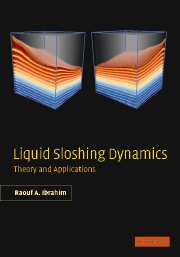Book contents
- Frontmatter
- Contents
- Foreword
- Acknowledgment
- Introduction
- Part I Linear sloshing dynamics
- Part II Nonlinear and parametric sloshing dynamics
- 4 Weakly nonlinear lateral sloshing
- 5 Equivalent mechanical models
- 6 Parametric sloshing: Faraday waves
- 7 Dynamics of liquid sloshing impact
- Part III Sloshing – structure interaction
- Part IV Rotating fluid and low gravity sloshing
- References
- Index
4 - Weakly nonlinear lateral sloshing
from Part II - Nonlinear and parametric sloshing dynamics
Published online by Cambridge University Press: 11 August 2009
- Frontmatter
- Contents
- Foreword
- Acknowledgment
- Introduction
- Part I Linear sloshing dynamics
- Part II Nonlinear and parametric sloshing dynamics
- 4 Weakly nonlinear lateral sloshing
- 5 Equivalent mechanical models
- 6 Parametric sloshing: Faraday waves
- 7 Dynamics of liquid sloshing impact
- Part III Sloshing – structure interaction
- Part IV Rotating fluid and low gravity sloshing
- References
- Index
Summary
Introduction
The linear theory of liquid sloshing is adequate for determining the natural frequencies and wave height of the free surface. Under translational excitation, the linear theory is also useful for predicting the liquid hydrodynamic pressure, forces, and moments as long as the free surface maintains a planar shape with a nodal diameter that remains perpendicular to the line of excitation. However, it does not take into account the important vertical displacement of the center of gravity of the liquid for large amplitudes of free-surface motion. It also fails to predict complex surface phenomena observed experimentally near resonance. These phenomena include nonplanar unstable motion of the free surface associated with rotation of the nodal diameter (rotary sloshing) and chaotic sloshing. These phenomena can be uncovered using the theory of weakly nonlinear oscillations for quantitative analysis and the modern theory of nonlinear dynamics for stability analysis. The main sources of nonlinearity in the fluid field equations appear in the free-surface boundary conditions.
The early work of nonlinear lateral sloshing is based on asymptotic expansion techniques. For example, Penney and Price (1952) carried out a successive approximation approach where the potential function is expressed as a Fourier series in space with coefficients that are functions of time. These coefficients are approximated by Fourier time series using the method of perturbation. The resulting solution is expressed in terms of a double Fourier series in space and time. This method was applied by Skalak and Yarymovich (1962) and Dodge, et al. (1965).
- Type
- Chapter
- Information
- Liquid Sloshing DynamicsTheory and Applications, pp. 209 - 295Publisher: Cambridge University PressPrint publication year: 2005

